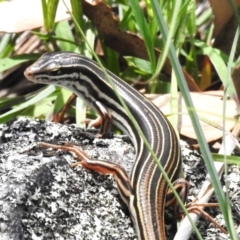Resin bee, Megachilid bee at Tennent, ACT
Identification history
| Megachile lucidiventris | 6 Nov 2016 | MichaelBedingfield |
Identify this sighting
Please Login or Register to identify this sighting.
User's notes
On the lower slopes of Mt Tennant, in Namadgi NP. Original ID by Ken Walker at BowerBird was Megachile (Eutricharaea) maculariformis, corrected by Michael Batley.
7 comments
roymcd
wrote:
2 Sep 2016
An interesting photo. It reminds me that I saw an Attenborough documentary on TV where a parasite burrowed into an ant's brain and made it climb a stalk of grass and bite on to it. Maybe a similar process at work here?
MichaelBedingfield
wrote:
2 Sep 2016
No Roy, nothing so sinister ! They are just settling down to roost for the night. It is common for Leafcutter bees to go to sleep in this way. They have strong jaws! Blue banded bees do it too.
michael.batley
wrote:
7 Nov 2016
Nice pictures Michael. They are, in fact, male resin bees belonging to the species Megachile lucidiventris.
MichaelBedingfield
wrote:
7 Nov 2016
Thanks for your comment Michael. Almost all the bee sightings on this website are mine and have been ID'd by Ken Walker from BowerBird.
I am happy to change this one because just from a look at other photos on the internet your ID seems better.
Have you had a look at the other sightings?
I am happy to change this one because just from a look at other photos on the internet your ID seems better.
Have you had a look at the other sightings?
michael.batley
wrote:
7 Nov 2016
I had not looked at the others, but now that I have, here are a couple of thoughts.
Amegilla cingulata has not been found south of Taree. My guess is that the first two Amegilla picutres are A. asserta and am fairly confident that the third the A. chlorocyanea.
The bee identified as Exoneura (Brevineura) sp. is Ceratina australensis.
The female bee labelled Lipotriches flavoviridis certainly belongs to the species complex that includes L. flavoviridis, but the orange tegula covering the base of the forewing suggests to me that it is Lipotriches phanerura and if the roosting males are the same size, as I suspect they are, then they, too are L. phanerura, not L. australica.
Bee identification is a lot of fun, but very difficult using photographs.
Amegilla cingulata has not been found south of Taree. My guess is that the first two Amegilla picutres are A. asserta and am fairly confident that the third the A. chlorocyanea.
The bee identified as Exoneura (Brevineura) sp. is Ceratina australensis.
The female bee labelled Lipotriches flavoviridis certainly belongs to the species complex that includes L. flavoviridis, but the orange tegula covering the base of the forewing suggests to me that it is Lipotriches phanerura and if the roosting males are the same size, as I suspect they are, then they, too are L. phanerura, not L. australica.
Bee identification is a lot of fun, but very difficult using photographs.
Please Login or Register to comment.
Nearby sightings
Location information
- Coordinates 149.056775-35.534170
- Altitude 677.4m
- Maps Namadgi National Park
- Places Tennent, ACT
Sighting information
- 4 - 15 Abundance
- 31 Dec 2014 07:53 PM Recorded on
- MichaelBedingfield Recorded by
Additional information
- 5mm to 12mm Animal size
Species information
- Megachile lucidiventris Scientific name
- Resin bee, Megachilid bee Common name
- Not Sensitive
- Local native
- Non-invasive or negligible
- Up to 680.3m Recorded at altitude
- Machine learning
- External link More information
Record quality
- Images or audio
- More than one media file
- Verified by an expert moderator
- Nearby sighting(s) of same species
- GPS evidence of location
- Description
- Additional attributes




















































































